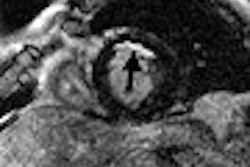
Consider the following St. Valentine’s Day scenario: Your beloved has gifted you with a fabulous bouquet of fresh roses. Their heady, sweet fragrance wafts around your office, lifts your spirits, makes you feel warm and fuzzy.
But just down the hall, your co-worker is awash in new cologne courtesy of his own honey bunny. And unfortunately, the odor doesn’t tickle your fancy. Every time you pass this person, in fact, the offending scent seems to slap you across the face. Your mood quickly sours.
Obviously, olfactory perception extends way beyond the nose and into the brain. The assumption might be that the brain’s response to a smell is intimately bundled with its intensity -- that bad smells are always stronger than good ones. But researchers from the U.S. and Austria used functional MRI (fMRI) to demonstrate that, in reality, two different areas of the brain -- the amygdala and the orbitofrontal cortex -- respond to varying degrees of pleasant and unpleasant smells.
In this study, "we took advantage of the unique world of odor where stimulus intensity, which is strongly correlated with subjective and autonomic indices of arousal, can be dissociated from stimulus valence," wrote Dr. Adam Anderson in Nature Neuroscience. "The view that the human amygdala is particularly responsive to unpleasant (or ‘negatively valenced’) events has been recently challenged by findings that the amygdala also responds to pleasant (or ‘positively valenced’) events" (February 1, 2003, Vol. 6:2, pp. 196-202).
Anderson and some of his co-investigators are from the Helen Wills Neuroscience Institute at the University of California, Berkeley. Other study authors hailed from the University of Vienna and Stanford University in Stanford, CA, including radiologist Dr. Gary Glover.
The strategy of this study was to dissociate the dimensions of intensity and valence by subjecting 16 healthy participants (8 women; 8 men) to four combinations of olfactory stimuli: intense-pleasant (a citrus-based smell); intense-unpleasant (a valeric acid, sweaty smell); unintense-pleasant (i.e. mildly pleasant); and unintense-unpleasant (mildly unpleasant). They then measured brain activation on MRI and computed the change in the blood oxygen-level dependent (BOLD) signal induced by the four odor combinations compared to a clean-air baseline.
MR imaging was performed on a 3-tesla Signa scanner (GE Medical Systems, Waukesha, WI) using a T2-weighted, spiral sequence (TE=30, TR=1 s, 64 x 64 matrix size, 220 field-of-view, 3.43-mm in-plane resolution, 17 slices, 4-mm slice thickness). Motion correction and minimal spatial smoothing was performed using SPM99 software (Wellcome Department of Cognitive Neurology, University College London, U.K).
Anatomical regions of interest were defined in each subject’s native brain space by a combination of structural and functional features (lateral, basolateral, and basomedial amygdala). Functional ROIs were defined by mapping the individual subject’s intensity, pleasantness, and unpleasantness ratings.
According to the MR results, a region in the right hemisphere of the brain, extending from the dorsal amygdala into the piriform cortex, was correlated with the intensity of the smell and not the valence. The authors surmised that the amygdala response reflected the intensity and not the valence of the olfactory experience.
"This preferential response to more intense stimulation remained when odors were equated for valence -- a greater response was present for valeric-high relative to valeric-low, despite being equally unpleasant in valence," they wrote.
Meanwhile, in the orbitofrontal cortex, the MR depicted a bilateral subcallosal gyrus activation that extended into the posteromedial orbitofrontal cortex. A response in this area was associated with pleasantness but not intensity. In addition, activations in the left anterior lateral and right anterior medial orbital cortical were associated with the unpleasantness of the smell regardless of how strong it was.
"In contrast with the amygdala, we found distinct orbitofrontal regions that were tuned either to pleasant or unpleasant odor quality rather than intensity," the authors wrote. "Activation in the right medial orbitofrontal gyrus was greater for pleasant than for unpleasant odors, regardless of intensity. In this region, both high and low concentrations of the pleasant-smelling citral induced strong and equal responses."
When it came to a whiff of clean air, the authors found that the subcallosal and posteromeidal orbitofrontal cortices responded more to clean air than to high- and low-intensity blasts of the unpleasant valeric acid. "This occurred despite a sniff of clean air being judged as far less intense than that of valeric acid," they said.
The present findings demonstrate a division of the neural space that processes smells into lower-order intensity and higher-order hedonic (pertaining to pleasure) components. Higher-order hedonic differentiation occurs in secondary olfactory regions, including the orbitofrontal cortex, they concluded.
So how does olfactory perception in the brain affect our emotions? These authors suggested that an emotional response -- happy about the roses; turned off by the cologne -- results from "(brain) activation along independent dimensions of emotional intensity and valence."
The response of the orbitofrontal cortex to olfactory stimulus is noteworthy, the authors pointed out. In particular, an activation or lack thereof in the subcallosal region of this area has been linked to depression, they stated.
In a separate study, researchers from Kiel University in Germany found that people who suffer from serious depression may have a reduction in smell sensitivity. Dr. Bettina Pause and colleagues examined the smell acuity of depressed patients compared to a control group and will report their results in the March 2003 issue of the Journal of Psychophysiology.
They found that depressed patients began to perceive a smell only at higher concentrations, and did not perceive weak smells at all. Pause hypothesized that the sections of the brain responsible for perceiving smell may be parallel, or even identical, to those that regulate mood and emotions.
By Shalmali PalAuntMinnie.com staff writer
February 14, 2003
Related Reading
Virtue its own reward, fMRI confirms, August 22, 2002
New fMRI studies show learning and judging in action, November 15, 2001
Neuroscientists map physiology of feelings, September 20, 2000
Copyright © 2003 AuntMinnie.com


.fFmgij6Hin.png?auto=compress%2Cformat&fit=crop&h=100&q=70&w=100)





.fFmgij6Hin.png?auto=compress%2Cformat&fit=crop&h=167&q=70&w=250)











